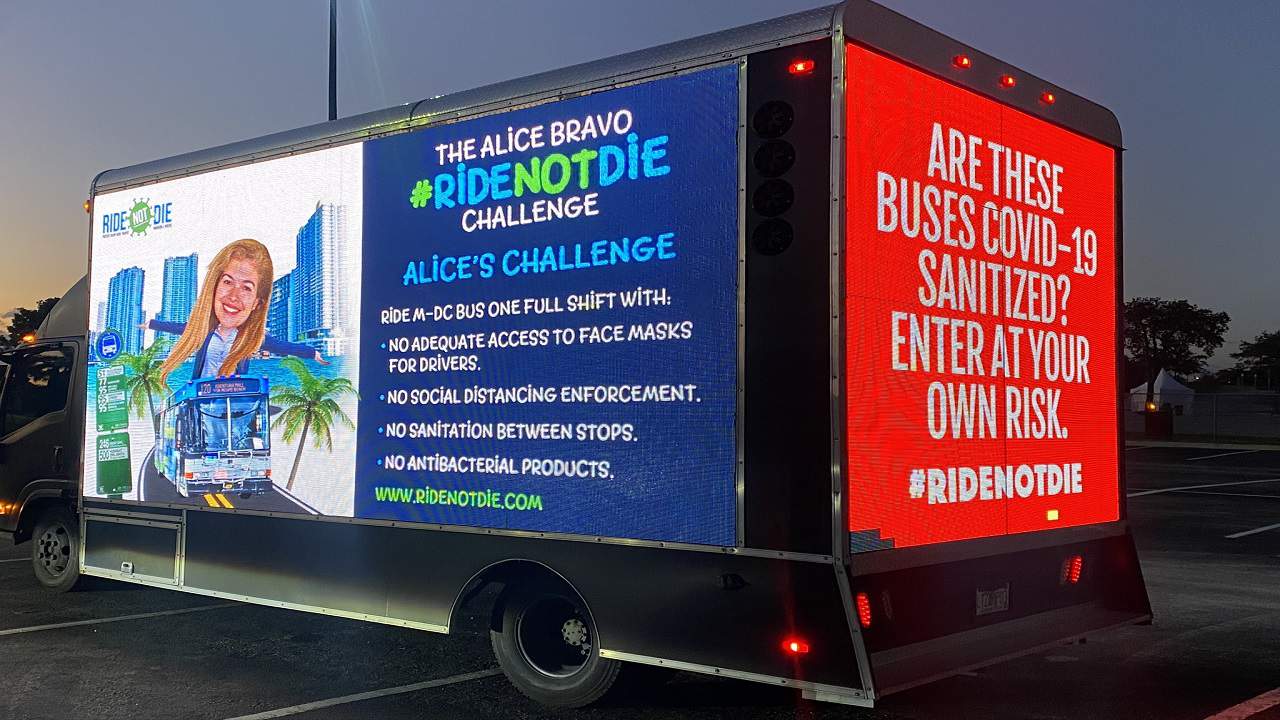Photo of Packed Bus Shows What's Wrong With Miami-Dade Transit
If during normal times a picture is worth a thousand words, during a pandemic some pictures are worth a thousand facepalms.
Take, for instance, a recent selfie from a Miami-Dade Metrobus driver showing about two dozen people packed on a bus around 6 a.m. this past Monday. They were on the heavily traveled bus route 11, which mostly runs along Flagler Street from Florida International University to Government Center in downtown Miami.
Miami-Dade Commissioner Xavier Suarez tweeted the photo, which the driver had sent to Jeffery Mitchell, president of the Transport Workers Union Local 291, which represents about 2,800 members in the county.
In the driver's selfie, caution tape can be seen cordoning off a section of the bus to separate the driver from passengers. There isn't enough room for people to exercise even a fraction of six-foot social distancing. A few riders are wearing facemasks, but most are not. And pretty much everyone looks miserable about the situation.
"Overcrowding on buses is exactly what you don't want right now," says Azhar Chougle, executive director of the advocacy organization Transit Alliance Miami. "It puts operators at risk, and it puts riders at risk."
This time last year, route 11 had nearly 200,000 boardings, according to county reports. But thanks to the new coronavirus, Miami-Dade has cut transit services, capacity, and space because of plummeting ridership. Recent transit changes have been made with little warning to the public, leaving people wondering why they're waiting longer for their rides. Service reductions, naturally, can contribute to a greater number of people packing available trains and buses.
For now, Miami-Dade County is urging people to avoid public transit except for essential trips. But some at-risk residents still depend on buses and trains to access medical care and social services. And people who can't work from home still need to get to and from their jobs. More than 90,000 occupied Miami-Dade housing units don't have a car, according to 2018 U.S. Census estimates.
Access to a vehicle can mean freedom for many people, but for those who don't have cars, driver's licenses, or insurance, it means dependence on an already inefficient and limited transit system likely to become all the more essential if people continue losing their jobs and cutting household expenses.
Mitchell, the union president, for weeks has said reducing transit service is not the answer.
"All those heavily traveled routes, the only way to relieve them is having more frequent buses coming through so you don't accumulate people," Mitchell says.
Alice Bravo, the county's director of transportation and public works, says that after seeing the driver's selfie, the county added more articulated buses — the longer ones with a joint in the middle — to route 11.
As for enforcing social-distancing measures on public transit, Bravo says drivers have been instructed to allow riders on every other seat, reducing capacity by 50 percent. Seats have been marked with an "x" to show which ones passengers may take. If too many people try to board the bus, drivers are instructed to tell them to wait for the next one so that riders aren't on top of one another.
"That's not the situation we want, and we are doing everything possible to enforce it," Bravo says.
She says county buses are equipped with counters to track the number of passengers. Supervisors are also keeping an eye on ridership along some routes. The transportation department is talking to the County Attorney's Office about whether transit riders can be required to wear facemasks, according to Bravo.
Mitchell says three transit employees — two bus drivers and a radio technician — have tested positive for COVID-19. Late last month, five bus drivers, a bus technician, and a transit operations supervisor were tested; a transportation department spokesperson says an update on those cases should soon be available. (A sixth bus driver who was tested received a negative result.)
Mitchell says the room where the radio technician worked was closed last week and cordoned off with caution tape so that no one would enter. The room was decontaminated two days later, Mitchell says.
Two unions representing more than 330,000 transit workers across the nation — the Transport Workers Union of America and the Amalgamated Transit Union — last week entered into an agreement to pursue "aggressive action" and place pressure on transit agencies that "are failing to take protective measures to safeguard transit workers, including the provision of masks and gloves." A media release from the unions says hundreds of transit workers in 20 states have tested positive for COVID-19. At least 33 Metropolitan Transit Authority workers in New York have died.
In Miami-Dade, transit workers have been low on masks, gloves, cleaning supplies, and other safety equipment. Bravo says that as of yesterday, all bus drivers had masks.
In case of a shortage, Mitchell has placed an order through Transport Workers Union of America for 10,000 masks and 10,000 pairs of gloves for the county's transit workers. Union funds will cover the order, he says.
"We're taking matters into our own hands," Mitchell says. "These people are out there every day risking their lives to keep people moving in the county. I would rather be safe than sorry. There's a whole lot of red tape when dealing with the county. And right now, there ain't time for red tape."






